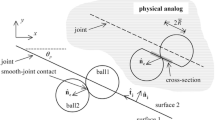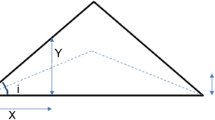Abstract
The variation of the shear strength of infilled rock joints under cyclic loading and constant normal stiffness conditions is studied. To simulate the joints, triangular asperities inclined at angles of 9.5° and 18.5° to the shear movement were cast using high-strength gypsum plaster and infilled with clayey sand. These joints were sheared cyclically under constant normal stiffness conditions. It was found that, for a particular normal stiffness, the shear strength is a function of the initial normal stress, initial asperity angle, joint surface friction angle, infill thickness, infill friction angle, loading direction and number of loading cycles. Based on the experimental results, a mathematical model is proposed to evaluate the shear strength of infilled rock joints in cyclic loading conditions. The proposed model takes into consideration different initial asperity angles, initial normal stresses and ratios of infill thickness to asperity height.
















Similar content being viewed by others
Abbreviations
- F :
-
Yield function
- σ n :
-
Normal stress
- i :
-
Dilation angle
- τ :
-
Shear strength
- φ b :
-
Basic friction angle of the joint surface
- G :
-
Plastic potential function
- i 0 :
-
Initial asperity angle
- u p :
-
Plastic shear displacement
- c d :
-
Damage coefficient
- dw p :
-
Increment of plastic shear work
- \(\tau_{\text{p}}^{\text{c}}\) :
-
Peak shear strength under cyclic loading
- N :
-
Number of shear cycles
- i n :
-
Normalised dilation angle
- D n :
-
Normalised degradation (normalised by maximum value of asperities amplitude)
- b, c, p, q :
-
Model coefficients
- t :
-
Infill thickness
- a :
-
Asperity height
- \(\tau_{\text{p}}^{\text{mi}}\) :
-
Peak shear strength of infilled rock joints under monotonic loading
- η 1, η 2 :
-
Model coefficients
- φ fill :
-
Infill material friction angle
- c 1, c 2 :
-
Model coefficients
- (t/a)cr :
-
Critical value of the t/a ratio after which the shear strength is only controlled by infill material
- C fill :
-
Cohesion of infill material
- σ c :
-
Uniaxial compressive strength
- E :
-
Young’s modulus
- C c :
-
Compression index
- C s :
-
Swelling index
- σ n0 :
-
Initial normal stress
- S :
-
Shear load
- W :
-
Width of the specimen
- L :
-
Length of the specimen
- N :
-
Normal load
- \(\tau_{\text{p}}^{\text{ci}}\) :
-
Peak shear strength of infilled rock joints under cyclic loading
- Δτ i :
-
Reduction in shear strength of infilled joints with increase in the number of loading cycles
- α, β, c 3 :
-
Model coefficients
References
Belem T, Souley M, Homand F (2007) Modeling surface roughness degradation of rock joint wall during monotonic and cyclic shearing. Acta Geotech 2(4):227–248
Belem T, Souley M, Homand F (2009) Method for quantification of wear of sheared joint walls based on surface morphology. Rock Mech Rock Eng 42(6):883–910
de Toledo PEC, de Freitas MH (1993) Laboratory testing and parameters controlling the shear strength of filled rock joints. Geotechnique 43(1):1–19
Fox DJ, KaÑa DD, Hsiung SM (1998) Influence of interface roughness on dynamic shear behavior in jointed rock. Int J Rock Mech Min Sci 35(7):923–940
Grasselli G, Wirth J, Egger P (2002) Quantitative three-dimensional description of a rough surface and parameter evolution with shearing. Int J Rock Mech Min Sci 39(6):789–800
Hutson RW, Dowding CH (1990) Joint asperity degradation during cyclic shear. Int J Rock Mech Min Sci 27(2):109–119
Indraratna B, Haque A, Aziz N (1999) Shear behaviour of idealized infilled joints under constant normal stiffness. Geotechnique 49(3):331–355
Indraratna B, Welideniya HS, Brown ET (2005) A shear strength model for idealised infilled joints under constant normal stiffness. Geotechnique 55(3):215–226
Jafari MK, Amini Hosseini K, Pellet F, Boulon M, Buzzi O (2003) Evaluation of shear strength of rock joints subjected to cyclic loading. Soil Dyn Earthq Eng 23(7):619–630
Jafari MK, Pellet F, Boulon M, Hosseini KA (2004) Experimental study of mechanical behaviour of rock joints under cyclic loading. Rock Mech Rock Eng 37(1):3–23
Jing L, Stephansson O, Nordlund E (1993) Study of rock joints under cyclic loading conditions. Rock Mech Rock Eng 26(3):215–232
Ladanyi B, Archambault G (1977) Shear strength and deformability of filled indented joints. In: Proceedings of the 1st international symposium on geotechnics of structurally complex formations, Capri, Italy, pp 317–326
Lee HS, Park YJ, Cho TF, You KH (2001) Influence of asperity degradation on the mechanical behavior of rough rock joints under cyclic shear loading. Int J Rock Mech Min Sci 38(7):967–980
Ma M, Brady BH (1999) Analysis of the dynamic performance of an underground excavation in jointed rock under repeated seismic loading. Geotech Geol Eng 17(1):1–20
Misra A (2002) Effect of asperity damage on shear behavior of single fracture. Eng Fract Mech 69(17):1997–2014
Oliveira DAF, Indraratna B (2010) Comparison between models of rock discontinuity strength and deformation. J Geotech Geoenviron Eng 136(6):864–874
Papaliangas T, Lumsden AC, Hencher SR, Manolopoulou S (1990) Shear strength of modelled filled rock joints. In: Barton NR, Stephansson O (eds) International conference on rock joints, 1990. Balkema, Rotterdam, pp 275–282
Papaliangas T, Hencher SR, Lumsden AC, Manolopoulou S (1993) The effect of frictional fill thickness on the shear strength of rock discontinuities. Int J Rock Mech Min Sci 30(2):81–91
Plesha ME (1987) Constitutive models for rock discontinuities with dilatancy and surface degradation. Int J Numer Anal Meth Geomech 11(4):345–362
Puntel E, Bolzon G, Saouma VE (2006) Fracture mechanics based model for joints under cyclic loading. J Eng Mech 132(11):1151–1159
Phien-wej N, Shrestha UB, Rantucci G (1991) Effect of infill thickness on shear behaviour of rock joints. In: Proceedings of the international symposium on rock joints, Loen, Norway, 4–6 June 1990, pp 289–294
Stupkiewicz S, Mróz Z (2001) Modelling of friction and dilatancy effects at brittle interfaces for monotonic and cyclic loading. J Theor Appl Mech 3(39):707–739
Xie H, Pariseau WG (1992) Fractal estimation of joint roughness coefficient. In: Myer LR, Tsang CF, Cook NGW, Goodman RE (eds) International conference on fractured and jointed rock masses, Lake Tahoe, California, USA, 3–5 June 1992. Balkema, Rotterdam, pp 125–131
Acknowledgments
The financial support from the University of Wollongong for this research is gratefully acknowledged. The authors wish to thank Mr. Alan Grant at the Engineering School of the University of Wollongong for his assistance in the laboratory work.
Author information
Authors and Affiliations
Corresponding author
Rights and permissions
About this article
Cite this article
Mirzaghorbanali, A., Nemcik, J. & Aziz, N. Effects of Cyclic Loading on the Shear Behaviour of Infilled Rock Joints Under Constant Normal Stiffness Conditions. Rock Mech Rock Eng 47, 1373–1391 (2014). https://doi.org/10.1007/s00603-013-0452-1
Received:
Accepted:
Published:
Issue Date:
DOI: https://doi.org/10.1007/s00603-013-0452-1




